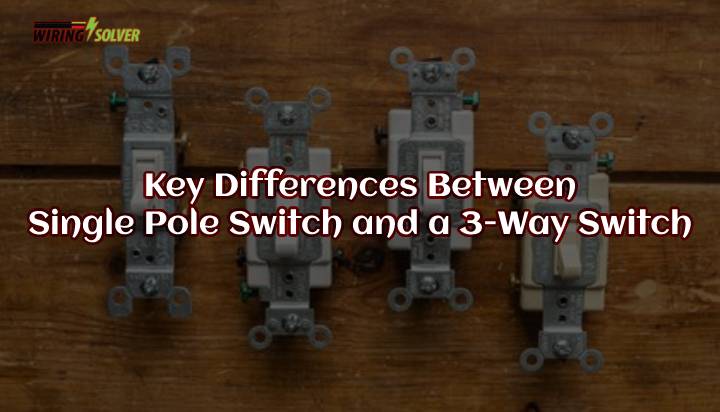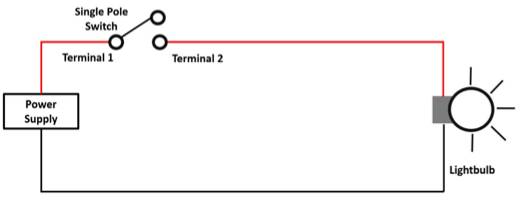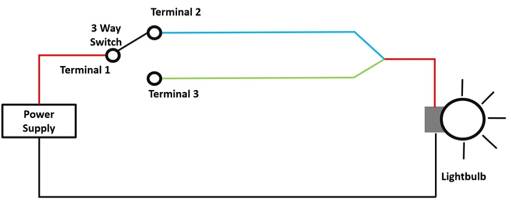Electrical switches come in various shapes and sizes. With the difference in appearance, comes the difference in functionality as well. Even though most of us are quite familiar with the regular single-pole switch and its functionality, most of us don’t know how 3-way switches function.
What’s the difference between a 3-way switch and a single pole switch?
To put it simply, a single pole switch can power only one circuit. But a 3-way switch can power two independent circuits. A single pole circuit has an off state. But a 3-way switch cannot be turned off. It can only be used to swap power from one circuit to another.
I will discuss more regarding the mechanisms of a single pole and a 3-way switch throughout this article. As well as the differences between a single pole vs 3 way switch.

What Is a Single Pole Switch and How Does It Work?
A single pole switch is like a gate that can either remain on or off. Flipping the switches changes the state of the switch. It can only operate one single circuit.

As can be seen from the above diagram (Fig 1), a single pole switch only has two terminals. And the switch only acts as a door or a bridge. Once the switch is pressed, the bridge is built, and the door is opened. And thus electricity can flow through.
Electricity can now flow through the switch to the device and back to the power source again. Thus turning on the light bulb or whatever the switch is connected to.
Single pole switches are generally used to operate typical household appliances and devices. That need to be turned off from time to time. As three-way switches cannot be turned off without the intervention of another intermediary switch.
Pros and Cons of a Single Pole Switch:
Pros:
- Simple to install.
- Easier to operate.
- Can be used to turn the circuit on and off.
- Cost-effective as oftentimes they are very cheap.
Cons:
- Cannot swap between two individual circuits.
- Cannot be used to create a 4-way switch mechanism.
- No flexibility of use.
These are some of the advantages and disadvantages of a single pole switch. If you wish to install a single pole switch you have to keep these factors in mind before installation.
Can I use a single pole switch for a 3-way? No, that would not be possible. As 3-way switches have three terminals and a single pole switch has only two terminals.
What Is a 3-Way Switch and How Does It Work?
A 3-way switch can swap between two different circuits. Flipping the switches changes the state of both the circuits, closing one and opening another. Thus it can operate two different circuits. But cannot turn off both the circuits at once.

As can be seen from the above diagram (Fig 2), a 3-way switch can interchange the state of both circuits. It can supply power through one circuit at one time. If the switch is pressed, electricity either goes through the first circuit or the second one.
If the switch is attached to two different devices, the switch can turn on both of these lightbulbs. But not at the same time. And it is also not possible to turn off any of the circuits without the help of another single pole switch.
When should you use a 3 pole switch? 3 pole switches are frequently used to control a light fixture from multiple places. This, however, requires a special wiring method. A household may include a set of three-way switches at different places so that lights can be switched on when reaching one room and then turned off when approaching another.
Pros and Cons of a 3-Way Switch:
Pros:
- Flexible to use.
- Can be used to operate two different circuits.
- Can be used to operate a single circuit from multiple places.
Cons:
- Harder to install by oneself.
- Wiring can be difficult.
- Can cost more than regular switches.
What Are the Differences Between a Single Pole and a 3-Way Switch?
There are several key differences between a single pole switch and a 3-way switch. Apart from their structural and functional qualities. I will go through their differences below.
Single Pole Vs 3 Way Switch
| Differences | Single Pole Switch | 3-Way Switch |
| No. of Terminals | 2 | 3 |
| Circuits Connected | One | Two |
| Flexibility of Operation | No | Yes |
| Cost | Less | More |
| Installation Procedure | Easy | Difficult |
These are some of the key differences between a single pole and a 3-way switch. The difference between a transfer switch Vs an interlock is a bit different.
Which Switch Should You Use?
Well, to be honest, it all comes down to your use case. And whether you’re ready to go through the procedure of installing a 3-way switch. Let’s take a look at the factors.
- No. of Terminals: A single pole switch has only two terminals, but a 3-way switch has 3 terminals. As it provides more functions than a single pole switch. You may want to connect multiple LED lights to one switch.
- Circuits Connected: A single pole switch can be connected to a single circuit. But a 3-way switch can be connected to two different circuits.
- Flexibility of Operation: A single pole switch can be only used to operate a single circuit. You can either turn it on or off. But a 3-way switch can be used to operate two different circuits. Or it can be used to operate a single circuit from two locations.
- Cost: Single pole switches tend to cost less than 3-way switches.
- Installation Procedure: The installation procedure for a single pole switch is very easy compared to a 3-way switch.
These are some of the factors that you should take into account before deciding to install either of these switches.
Summary
In this article, I have explained in detail, the key differences between a single pole vs 3 way switch. I have also brought up how each of these switches can affect a circuit and its components.
This article also showcases both the advantages and disadvantages of each switch type. You must choose which switch to use according to your requirements. If you feel a bit indecisive, do not hesitate to ask for advice from a professional.

![Kasa Smart Switch TroubleshootIng! [Complete Guide]](https://wiringsolver.com/wp-content/uploads/2022/10/How-to-Troubleshoot-a-Malfunctioning-Kasa-Smart-Switch.jpg)
![Eaton 4-Way Switch Wiring With Diagram [Complete Guide]](https://wiringsolver.com/wp-content/uploads/2022/10/Wiring-Diagram-with-Instructions-for-an-Eaton-4-Way-Switch.jpg)



